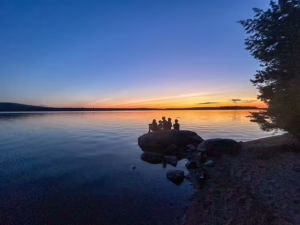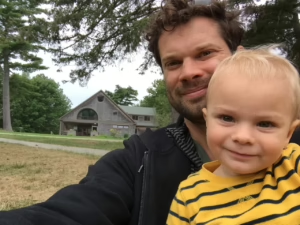July 4, Chewonki Campfire Circle. Six Camp Boys, two counselors, and a counselor-in-training spent the morning at Campfire Circle, whittling, building small campfires, concocting “pitch glue,” and fortifying the forest shelters they’d designed and built. Parades, carnivals, and crowded beaches seemed a world away.
This is Chewonki Woodcraft, and please don’t make the mistake of confusing it with Woodshop. In Woodshop, boys learn to make objects out of wood (boats, planes, boxes, etc.). In Woodcraft, boys go outside to learn the tricks of an outdoorsman’s trade.
The goal is to teach campers skills that will make them comfortable and capable in a wilderness setting. Whether they intend to be survivalists or recreational campers, says Osprey counselor and Woodcraft leader Alex Chasse, “Knowing how to use natural resources to your advantage is key.” Assisting Chasse, who grew up in Fort Kent, Maine, were fellow Osprey counselor Brian Horan (of St. Petersburg, Florida) and counselor-in-training Oliver Morton (of Somerville, Massachusetts).
The boys—Calvin, Jackson, Keaton, Oliver, Tedy, and Wyeth—were excited, focused, and eager to share their know-how with a visitor. Wyeth gave a detailed description of how to make glue, handy for repairing tents and tools and waterproofing containers, from pine sap and crushed charcoal. Tedy explained the advantages of dry pine needles as a fire starter. Oliver and counselor-in-training Morton quietly whittled away at branches they were turning into walking sticks.
“You’re in my blood circle!” warned Oliver-the-Younger, extending his whittling arm toward the visitor when she moved too close. “You need to stay beyond the reach of my knife to be safe.” Done.
Later in the morning, Chasse, Horan, and Morton tested the waterproofness of individual shelters the campers had built from debris on the forest floor. Anticipation was running high, with some boys sure their designs would keep them dry while others expected to get wet but had no regrets on this hot day.
In other Woodcraft sessions, campers will make simple edged tools; learn how to use a map and a compass; acquire or refine canoe paddling skills; practice knots; and acquire techniques for open-fire cooking with flair.

Woodcraft has a distinguished history at Chewonki, not surprising for a camp started by someone (Clarence Allen) who believed that outdoor living and love of nature were good for mind, body, and spirit. Below are some references to Woodcraft in early issues of the camp newspaper:
Woodcraft – 1933
“Recently, groups of boys have been introduced to the fine art of outdoor cooking. From now on, there will be many such groups out every evening when the weather is fair.”
Woodcraft – 1942
To the boys: “More might have been accomplished in woodcraft this summer had the time and the weather permitted. I feel sure that your Camden trips and canoe trips showed you exactly ‘how it’s done.’ Much enthusiasm was shown by the seven boys who now have credits. The following of a trail which ended at a steak fry was one of the highights of the season…I hope that you remember how to split the firewood for your furnace for possibly this winter and probably next winter.”
—Joe Camden Scott, Megunticook Dave, and Ragged Ronnie
Woodcraft – 1952
“The woodcraft departent has enjoyed a summer of fine opportunities and exceptional boys…By the time the season was over, most of the boys who undertook the woodcraft program had successfully completed most of their tests and were judged by their mentors as well versed in the ways of living in the woods…In addition to canoeing, the boys were also instructed in differentiating tree species, sleeping out, pack making, and wet and dry firebuilding.By far the highest point in the program was the seven-day Katahdin trip. We were able to take ten boys on this outing, and to a man they were cheerful, competent, and rugged…[W]e want to congratulate Timmy Ellis for winning the award of ‘Best Woodcrafter’…”
—Gordie Hall and Phil Wheeler
Woodcraft – 1967
“…{This] is what camping is: companionship, cooperation, and a strict attention to what needs to be done. To me the goal of camping is relaxation…Don’t get me wrong. This relaxation, like most anything else, can only be achieved through hard work. It is a relaxation that is the sum of confidence, a feeling of accomplishment, and an appreciationof the out-of-doors…We all join in thanking you, our students and companions, for the enthusiasm that may have made 1967 the ‘woodsiest summer in Chewonki history.’”
—Tom Bertocci
Woodcraft – 1991
“Wow, what a summer. Woodcraft acctivities were well attended by Puffins, Owls, Herons, and Ospreys. Wood skills seemed to have beeen the most popular, followed by wilderness skills and canoeing…Campers learned a veritable plethora of techniques ranging from sawing and splitting to minimum-impact camping to canoe-over-canoe rescues…”
—Nelson Lebo
There was something eminently peaceful about this small band working with enthusiasm in the sunlight and deep shadows splashing Campfire Circle on Independence Day 2018. Whether they knew it or not, boys were engaged in their own celebration of independence as they practiced the skills their counselors were teaching them—skills that could well last a lifetime.














